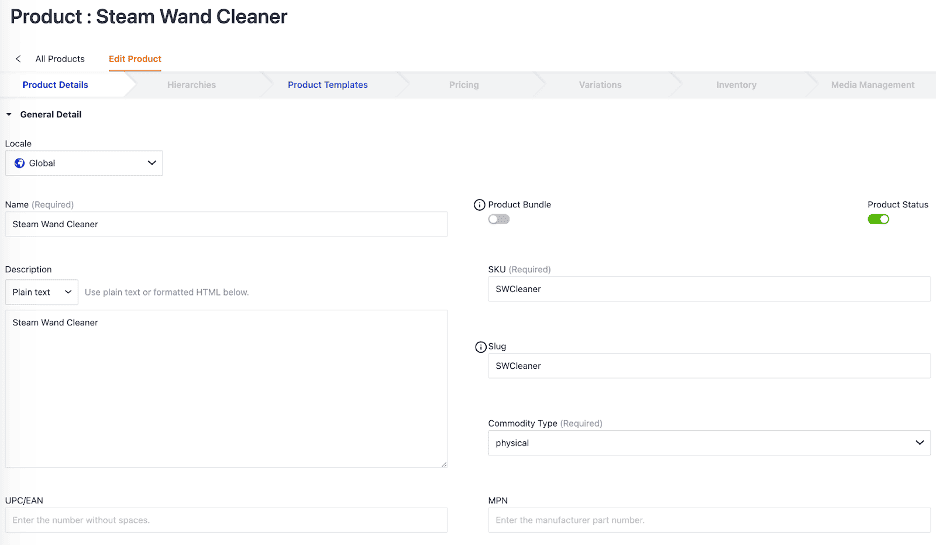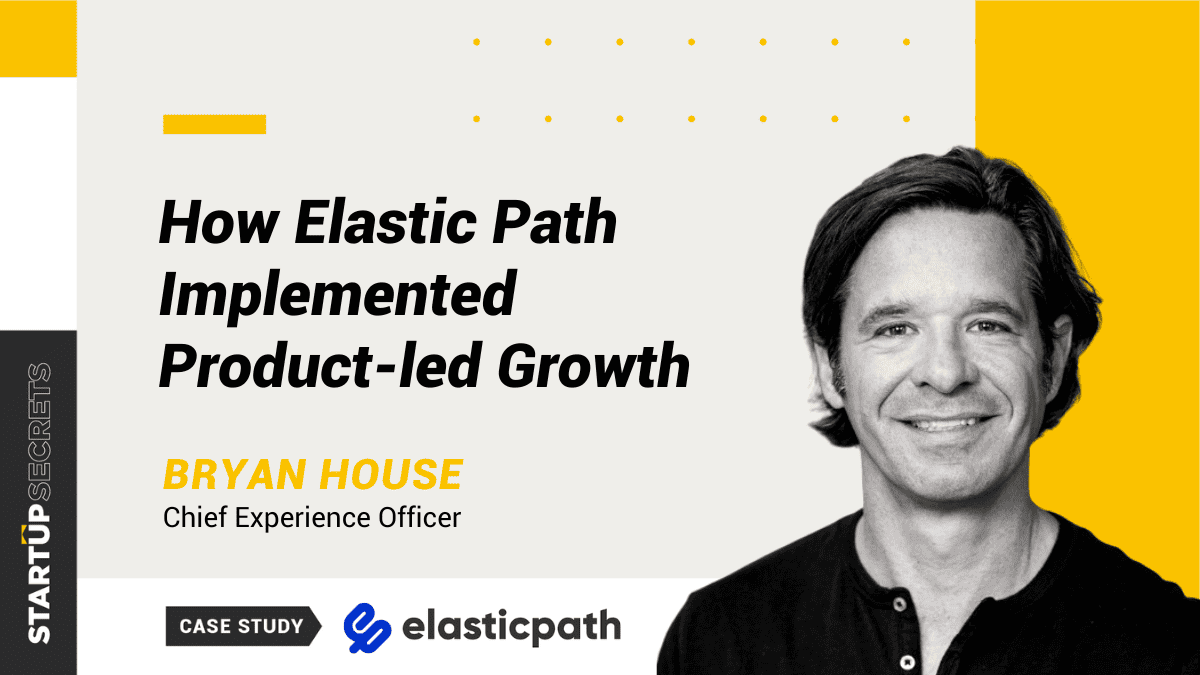This article was written by Bryan House, Chief Experience Officer at Elastic Path and Core Partner to Underscore portfolio company CloudZero. As an experienced tech entrepreneur, Bryan has extensive experience leading sales, account management, product marketing, and digital organizations.
Product-led growth (PLG) has gone from a fringe go-to-market (GTM) strategy to a primary growth lever for many SaaS companies. According to the OpenView Partners 2022 Product Benchmarks report, the adoption of PLG is up by 20% over the last three years. In 2023, 91% of B2B SaaS companies plan on investing even more in PLG.
If you’ve landed here, you probably don’t need more evidence that PLG works in theory. You want to know why and how you should implement it in practice.
You’re in the right place.
Transitioning Your Team to Product-led Growth
Historically at Elastic Path, we’ve had to navigate a complex, multi-stakeholder buying process to sell our commerce software. The enterprise RFP process is long, simply because that’s “the way it’s always been done.”
However, commerce teams increasingly demand hands-on experience with new software before making a purchase. We believed that if developers and builders could get their hands on our product, they would see its value for themselves. That would accelerate sales cycles, increasing the efficiency of our enterprise sales team. And who doesn’t want a more efficient sales cycle in a tough economy?
So, we implemented a PLG strategy to enhance our GTM mix.
This guide will show you what motivated us to do so—and how we executed it. Even though the path wasn’t linear, the strategy is proving to be worth it.
Is PLG right for your business?
As we’ve experienced in the past five years or so, the modern enterprise software buying cycle looks far different than it has in the past. Most buyers expect to self-evaluate products, and their journey is hardly linear.
This means the role of sales must evolve. Instead of the old-school gatekeeper, SaaS sales must help self-directed buyers get more value out of the product, particularly for complex products or multi-stakeholder scenarios.
Some may question, “Should we even bother with a PLG strategy if our product is complex?” I’ll get to that later in this article.
A more important question is, “Are you ready for a cultural change?”
Many companies make the mistake of bolting on a free trial and thinking they’ve cracked the code on PLG. In reality, the transition to PLG has as much to do with your team as your product.
Are you prepared to change the way you do business, to focus maniacally on driving value for the customer? How can you help them get to their “a-ha” moment faster? Answering these questions will help you decide whether PLG is right for you.
You might say, “But wait, we have a proof of concept (PoC). We even call it a proof of value (PoV). Isn’t that enough?”
In some cases, it may well be. But in my experience, PoCs and PoVs are typically driven by a prospect who does not yet understand your unique value proposition. The result is an inconclusive effort that reinforces the problem the prospect is facing, but often not what your solution does uniquely well to solve that problem.
To make a GTM strategy “product-led” and give your program scale, you have to design the entire product experience to drive and reinforce those “a-ha” moments. The downstream benefit is that you start creating a better product experience for everyone.
PLG vs. SLG: It’s not a binary decision.
Some people make the mistake of thinking they need to ditch their salesforce in favor of a PLG approach. That couldn’t be further from the truth. PLG and sales-led growth (SLG) naturally reinforce one another.
In fact, there comes an inflection point in a PLG company’s growth where adding an enterprise salesforce makes sense. Buyers and users aren’t always the same people in a large enterprise. In those scenarios, a product can make inroads with users who become product-qualified leads (PQLs), shortening sales cycles for the sales team.
If you already have an enterprise salesforce, the main challenges that hold you back from implementing PLG could lie within the product itself. For complex products and multi-stakeholder buying cycles, PLG opportunities may not present themselves in a straightforward way.
Does product-led growth work for complex scenarios?
We navigated through this exact issue at Elastic Path. Commerce implementations often involve both business and technical stakeholders, so there’s not a straightforward end user like we often see with many B2C PLG products. Plus, composable commerce products are highly customized to an enterprise’s needs and IT environment, which makes them more difficult to demonstrate through a free trial or freemium product. It got me thinking: Does PLG look different for commerce?
In our case, many commerce buyers were already doing their own PoC by standing up Shopify experiences. Once they became frustrated with the limitations of Shopify, they started seeking out more functional alternatives.
That was the lightbulb moment. Prospects were used to labor-intensive RFPs and complex enterprise buying cycles in commerce, and they were unknowingly trying to circumvent this clunky process with Shopify. What if we removed Shopify as the unnecessary PoC step?
Making our product easier to try with assisted self-discovery could successfully thread the needle between the technical buyer and the business buyer. Technical buyers want to get hands-on with the product—fast. Our product itself could orchestrate the “a-ha” moments for them. The business buyers, on the other hand, would require more of a relationship-based sales approach paired with the product experience.
So we set out to answer two key questions:
- Could a product-led GTM motion increase the quantity and quality of our lead flow?
- Would this lead flow accelerate logo acquisition efforts, giving us a larger pool of accounts upon which we could run a land-and-expand sales motion?
Short answer: We’re just getting started, but it’s working. Follow along with our process below to see what we did, and how you can apply these concepts to your business.
Step 1: Making the Plan
The goal of our PLG plan was to set our defining principles, create some preliminary targets for success, and map out how we would design our new product experience. This plan would also allow us to get executive buy-in and address any concerns from the team.
Our implementation plan for a product-first approach consisted of three phases. This design would enable us to time our hiring appropriately, learn as we go, and scale when we have confidence in our ability to convert prospective trial users into successful, paying customers.
Phase 1: Product Readiness
In phase one, we would hire the right product data management, UX, and front-end development resources. The primary objective would be to review previous PoCs, identify patterns of engagement, and build learnings into our product-led growth efforts.
This phase took approximately one quarter to execute.
Phase 2: GTM Readiness
In phase two, we would expand the GTM team to include developer evangelists, presales specialists, and digital marketing resources to support the product development efforts.
The objective of phase two would be to orchestrate the customer journey from the website into the trial, creating our first cohorts of trial users.
This phase lasted approximately two quarters, and as of this writing, we’re just wrapping it up.
Phase 3: Customer Acquisition Scale-Out
In phase three, we would turn on the gas for this program. From phases one and two, we would have a better understanding of the required product experience by persona, conversion moments, level of engagement along the way, and post-trial steps to convert to paying customers.
The primary goal would be to fill the trial program and dramatically increase top-of-the-funnel demand for all of our sales efforts—and accelerate days-to-close for a portion of our deals.
Elastic Path’s Guiding Principles for PLG
We landed on the following:
- Orchestrate an assisted journey of self-discovery for Elastic Path Commerce Cloud for prospective technical and business users.
- Follow an approach of help/assist/learn rather than sell. Show rather than tell; hands-on experience trumps assurances of the same.
- Presales to work closely with prospects as early as possible to guide journeys to desired outcomes.
- Use cohort analysis to provide a foundation for experimentation and continuous improvement.
- Gross Merchandise Value (GMV) under management is the north star metric to measure the overall program effectiveness.
Evangelizing the Jobs to Be Done
One of the biggest mindset shifts for us was around evangelizing jobs to be done. We knew prospective buyers found Elastic Path because they had a problem to solve; they were looking at commerce software to address a job that needs to be done.
While our website addresses buyer personas and their needs, we focused additional content on how Elastic Path uniquely solves these problems.
But this transition was not about the content on our website alone. Times have changed; our product could no longer be a downloadable binary behind a link buried on a gated page for paying customers only.
The Elastic Path “product” had to become the entire experience—starting from the moment a prospective buyer visited any page on our website. Rather than making the prospective buyer navigate through multiple gates to prove they are qualified for our time and commerce expertise, we had to enable our product to speak for itself.
Step 2: Building the Team
Our next step after making the plan and gaining buy-in was to assemble a team. The goal was to focus on building a thoughtful UX for developers, who were our primary product evaluators. To that end, the first four roles we wanted to hire were as follows:
- UX designer: This role would be dedicated to redesigning the product experience for PLG.
- Front-end developer: Our goal was to find an experienced front-end developer who brought a strong point of view on how developers want to evaluate new products.
- Product manager: This role would define requirements for the PLG experience and bring market research to the team to inform decisions.
- Developer advocate: As an API-first, microservices-based offering, we knew a critical component of any evaluation would be the developer experience.
After we hired these roles, we knew we needed someone to step into a product operations role. Many PLG and free trial efforts fall over because of a failure to instrument and measure all components of the experience. From the very start, we needed to track and analyze what was working and what wasn’t at a detailed level.
Luckily, a current team member expressed interest in taking the lead for product operations. They’re working with Pendo, FullStory, Datadog, and Salesforce integrations to understand how well our product experience is converting. We wanted to have enough data to drive design decisions across the experience.
Another existing team member stepped into the role of technical pre-sales. This role supports the principle of assisted self-discovery. Our technical pre-sales employee is dedicated to the product-led growth experience to answer questions and provide direct one-on-one assistance in our developer community channels.
The next role we’ll hire will be focused on enablement. Fortunately, we already have a strong enablement team at Elastic Path. Given that our PLG experience is focused on assisted self-discovery, this person’s role will be to develop hands-on learning content to both learn about our product and discover the “a-ha” moments that make it unique.
As of this writing, we feel that we have a strong team in place to execute the next phase of our PLG initiative. Future hires could include:
- Director of growth: This individual would be responsible for overall program success and improving results of the program over time in the form of demand generation, opportunity creation, and ultimately our north star metric of GMV under management.
- Other potential hires: These roles could include customer support for PLG users and demand generation to drive more leads through PLG.
Step 3: Building (and Simplifying) the PLG Experience
When you have a product that’s infinitely customizable, it can be hard to whittle the product experience down to what’s absolutely necessary for the prospect to see and do.
Our product is an API-first composable commerce experience, and part of our value proposition is the fact that you can customize the exact technology your company needs while cutting out the bloatware of legacy commerce platforms.
However, along with the prospect of composable commerce comes the paradox of choice. If products are too complicated, users won’t find any value, and they’ll jump ship. You don’t start a new guitar player’s first lesson with a Jimi Hendrix solo. They’d get too frustrated and quit before they mastered their first chord. In other words, more is less.
Focusing on a Key Competitive Differentiator
To build an effective PLG experience, we had to key in on the most valuable competitive differentiator for our product. For us, that was the product catalog.
While the catalog issues brands face are diverse, consumers can often tell when an online commerce catalog experience is broken. For example, you’ll see many popular sites living with broken “shop the look” experiences.
Gorgeous, catalog-like landing pages promise consumers the option to buy the exact item they see in the photo in one click. Instead, consumers have to sift through endless options to get the actual size and color pictured. Many get frustrated and abandon the site altogether.
Our PLG experience had to reel prospects into the art of the possible by demonstrating “a-ha” moments with our catalog offering. We had to accomplish this without overwhelming prospects with too many possibilities. As they say, with great power comes great responsibility.
For our orchestrated self-discovery journey, we knew we had to nail the intersection of things the customer must do vs. things the customer must see (our unique value prop). Doing so would create the opportunity for us to stand out and help us create a better product in the process.

Setting up a new product in the Elastic Path catalog experience
Our previous PoC featured too many options. Using FullStory, we were able to see where prospects were getting stuck in the product experience.
The short version of the story: They were getting stuck early and often. Our PoC required detailed understanding to even create the first product in the catalog. Our key takeaway? Instead of throwing every possibility at the prospect up front, we had to show them exactly how to set up one of their own products and put it in the store.

Refining product details in the Elastic Path catalog
Our journey with refining the product experience is far from over. We’re still learning and iterating based on the friction we see our prospects encounter. Witness friction, take away friction. It’s a continuous cycle. The goal is to get prospects from being proficient in our product to being an expert in the shortest amount of time.
If you’re building your own product-led growth experience, my best advice is to keep it simple. Understand what people are trying to do with your product, and help them achieve it seamlessly.
Let them see themselves in your experience. That means getting them to do things that highlight your unique differentiators—or things you can do that none of your competitors do well.
Step 4: Measuring Success
Early signals from our PLG experience are positive. We’re measuring conversions such as:
- Visitors to activations
- Sales conversations to leads
- Leads to qualified opportunities
Initial data suggests we are doing well in converting sales conversations to leads. It’s still early days, and we’ll want to learn more about how much more our prospects can do further down the funnel.
Our next steps will be defining and measuring engagement in the form of PQLs. After prospects interact with our experience and reach a certain threshold, they’ll become PQLs. Our sales team will engage with these leads, leveraging data on how they’ve interacted with the product.
If all works well, this will have a positive impact on sales time to close. We’ll continue optimizing our PLG experience using our product instrumentation tools and fine-tune it as we develop new features and key differentiators.
What’s Next?
Our experience with PLG goes to show that it’s well worth making it easier for the prospect to solve their own problems. Even more complex technology with multiple stakeholders can incorporate PLG into their GTM motion.
In our case, the business stakeholder had the problem to be solved, but the technical stakeholder was the one charged with solving it. The same holds true for a lot of business-user-oriented software products that require a developer to customize.
This dynamic shouldn’t turn you off from product-led growth. Most developers and technical experts would rather just try a product on their own vs. go through an extensive RFP process with multiple vendors.
In short, PLG makes things a lot more efficient. Your prospect’s journey to “a-ha.” Your sales cycle. Your onboarding process and path to proving customer value. Even your product itself. Is it time for you to take the leap?










